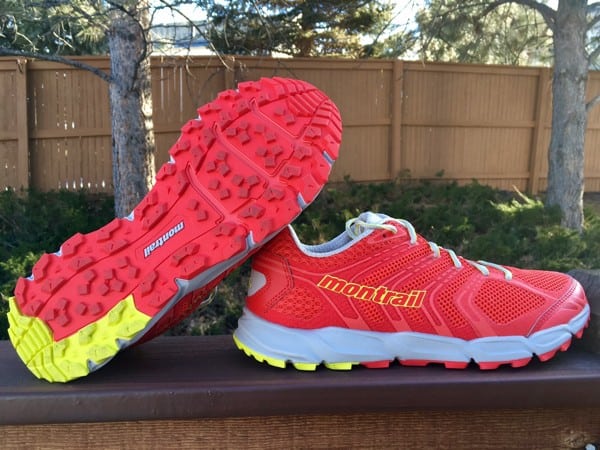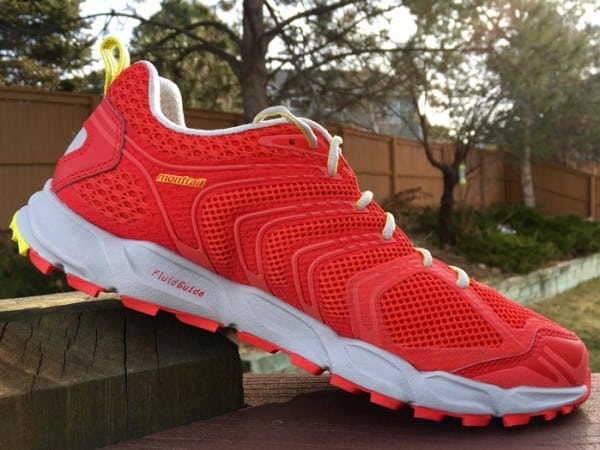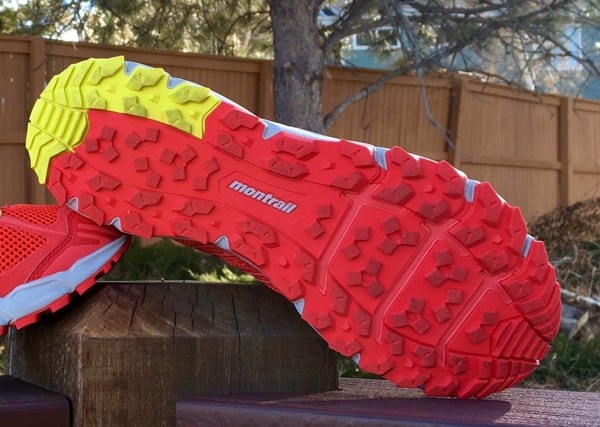Our Favorite Trail Running Shoes
Check out our Best Trail Running Shoes article to learn about our current favorite trail running shoes!
Montrail Caldorado Review
Ah, Montrail. You made the first trail running shoes I ever purchased back in 1997 and the shoes I ran my first several ultras in—the Vitesse. I was true to the Vitesse until I could no longer find it deeply discounted but still ‘fresh.’ I’ve dabbled in the Mountain Masochist I and II and the Bajada as well with some positive takeaways, but the true ghost of Vitesses past lives on only in my memory.
A new offering for Spring 2016 is the Montrail Caldorado ($120) (9.1 oz women’s/11.0 oz men’s). In a nutshell, I felt like this shoe takes the breathability of the Bajada and combines it with the protection and all-trail ride provided by the Masochist with a bit of the old Vitesse mountain spirit mixed in for good measure. In technical jargon, they’ve combined their newer FluidFoam and FluidGuide technology with a TrailShield protection plate to create a shoe that provides excellent protection while still maintaining a relatively responsive, well-cushioned, and marginally flexible all-trail shoe. It has an 8mm drop and sits at 11mm in the forefoot and 19mm in the heel, so though it might look a bit stacked, I didn’t feel like I sat high in the shoe at all.
It’s winter here in Colorado, which means lots of miles on snow ranging from postholing and fluff to packed hard like a highway, ice, occasional mud, and some hard-packed dry dirt thrown in. Luckily, I had a lovely long-ish holiday in the rocky, dusty, sandy, hard dirt trails and rock paths of the Arizona desert where I was able to really put my Caldorados to the test. They really shined in this environment in almost all aspects. Back in Colorado, they performed as well as any similar-treaded shoe on the snow. I wear Kahtoola Microspikes for the ice, and they hold up well to the tension and pressure of the metal and rubber contact points. As for performance on mud, I still prefer my well-lugged shoes, but again, they performed adequately for short stints in our moon-boot-forming clay. My guess is they’d be a little slippery in the wet muck of the Pacific Northwest, but I didn’t get to travel there during this testing period.

The Montrail Caldorado. All photos: iRunFar/Kristin Zosel
Upper
The upper is seamless with overlays bonded medially and laterally to provide more stability to the layers of mesh that allow for excellent breathability while still keeping the sand, rocks, and cholla cactus out of the shoe. While you can feel the bonded overlays from the inside with your finger, I never noticed them while running and hiking over uneven rocks or while running on smooth connector dirt roads and singletrack. The mesh layers of the upper also worked well to prevent low-moisture Colorado snow from building up around the exterior of the shoe despite the fact that the shoe has no waterproof membrane. (Montrail does make a version of the Caldorado with their OUTDRY waterproof-breathable membrane, but I didn’t test that.) I felt like the shoes dried rather quickly after snow runs as they were always dry the next day. The gusseted tongue extends to just before the most proximal two lacing holes nearest your ankle and provided standard protection from laces and brush. Again, I had no trouble with any debris getting in via this route despite not bringing any gaiters to the desert.
The heel cup is quite firm and supportive and extends forward a bit further than more flexible or minimalist shoes. This enhanced stability in the off-camber terrain. The padded ankle collar and Achilles notch was perfect for protecting my foot and ankle in the rocky sections but wasn’t noticeable when I was running smoother lines. The Achilles notch was unobtrusive on sharp downhills as well. A relatively firm and protective rubberized toe cap protects the sides and front of the toes distal to the ball of the foot. I really liked this, again, where rocks were uneven and sharp things abounded. With all the abrasions these shoes received in the desert plus the miles with Microspikes strapped on, the upper has held up very well. I see no signs of wear and tear at the junction with the midsole or anywhere else except for one tiny divot out of the toe cap rubber. I can say that the divot was well earned up on the Peralta Trail in Arizona’s Superstition Mountains; it saved my toe and my run that day.
While I really appreciated almost everything about this upper and its ability to handle the various environments, I had one major challenge for about the first 70 miles. The mesh layers are stiff enough in the toe box that on push off, they fold directly onto the top of my great toenail and on across the forefoot. This actually caused noticeable soreness and pressure in the great toenail the first several runs. After it was ‘broken in,’ I no longer noticed it; however, I’ve come to expect that I shouldn’t have to break in my running shoes, so this was a disappointment. I’m curious if this would be even more uncomfortable with the added OUTDRY membrane. If you do get these shoes, have patience with them in the first few weeks and perhaps consider not wearing them out of the box to your next ultra.
A note on fit among brands and models, I find these sizes to be comparable: women’s size 9 in the Montrail Caldorado, women’s size 9 in the Pearl Izumi Trail N2 v2, women’s size 8.5 in Salomon Speedcross, and women’s size 9.5 in La Sportiva Mutants.

The Montrail Caldorado lateral upper.
Midsole
Again, I felt like these shoes needed a bit of a break-in period as when I initially wore them on local trails, the whole shoe tended to tip medially or laterally when I’d run on frozen mud and ruts in the first few weeks I had the shoes. Once the torsional stiffness softened a bit, I felt like my ability to conform to sharp unevenness improved. I didn’t notice this as much when I took the shoes to Arizona, but I think that was more likely due to having more miles in the shoe. The cushion provided by the midsole was rather comfortable as I ran my daily desert miles. These were the only pair of shoes I took and they were as comfortable on day 9 as they were on day 1. The FluidFoam is the responsive foam Montrail blends with the FluidGuide higher-density foam to give a smooth ride with just enough support to help the foot and ankles remain neutral as you run over more technical terrain.
I was repeatedly thankful for the TrailShield molded rock protection plate as well as the flex grooves integrated with it. I ran 80-plus miles in the rocky desert without any stone bruises or soreness on the bottom of my feet. I would say, if you’re used to a fairly flexible shoe like the Pearl Izumi N2 Trail version or something even more flexible, this shoe might feel a bit thick or unresponsive. I tend to prefer more protection to less even if it sacrifices ground feel, so I didn’t mind it. I also felt the shoe rolled along well on the smoother dirt-road connectors.
In the snow, I appreciated the protective ride of the Caldorado as I played the every-step-forward-slides-a-half-step-back game on the uphill somewhat-packed-snow sections. My toe flexors were never overextended on push off, and when I did wear my Microspikes, I didn’t feel sore from the pressure of the metal underfoot. The foam of the midsole has thus far maintained its responsiveness despite temperature swings from 15 to 75 degrees Fahrenheit as well as the very low humidity it’s been subjected to over the past 150 miles.

The Montrail Caldorado medial upper.
Outsole
If I lived in an area where I’d be running lots of slickrock, these are the shoes I’d wear. The outsole consists of 5mm square lugs arranged in triangular patterns or clumps with directional ridges at the distal forefoot and final aspect of the heel to help with push off and heel strike. The traction provided by the sticky rubber on rock and angled hardpack (especially slickrock) is outstanding. If you add a layer of grainy sand or water, the shoes still keep you upright and confident about your path even if you’re cautious like me. The lugs have some difficulty shedding clay mud but work fine in wetter dirt as long as the depth of the muck is shallow. They are not deep lugs, so don’t expect deep-lug performance in the greasier gunk. In the 150 miles I’ve run in these, the tread shows very little wear and tear. I’m rather impressed with this given the terrain they’ve navigated, and I look forward to seeing just how long I can run in these especially after we get more dry trails in our area.

The Montrail Caldorado outsole.
Overall Impressions
The Montrail Caldorado is a solid shoe on the ‘sturdier’ end of the spectrum, once you get past the first 70 miles or so and the mesh on top of the forefoot softens up. This and the initial torsional stiffness, which also took 70 to 80 miles to loosen up, were my only two complaints about the shoe. If I was heading to Moab, Utah for a spring race on slickrock and dirt roads or down to Colorado Springs, Colorado for one of the runs in Palmer Park, the Montrail Caldorado would be my likely shoe. What is sacrificed in responsiveness and flexibility is more than made up for in the rock protection and stability over rocky and technical terrain. This isn’t a minimalist shoe, nor does it try to be. I think Montrail is on the right track with this shoe, and I look forward to seeing how it evolves.
Call for Comments (from Meghan)
- Have you tried the Montrail Caldorado? What are your overall impressions of the shoe?
- Under what conditions has the outsole best performed for you?
- Have you found there to be a break-in period for the shoe on your foot, too?
